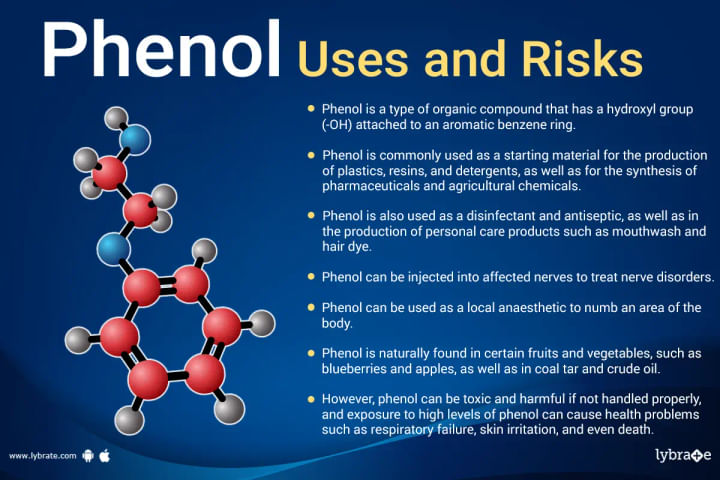What Is Phenol?
Phenol, which is also commonly referred to as carbolic acid, is a naturally occurring aromatic organic compound. C₆H₅OH is its molecular formula. Moreover, phenol can be best defined as a white crystalline solid that has a volatile nature and a strong, astringent odor.
The molecule is made up of a phenyl group and a hydroxy group that are held together by a covalent bond. Furthermore, it is important to keep in mind that phenol is corrosive and can cause chemical burns, so it should always be handled with a lot of care. Phenols, which are similar to alcohols, form stronger hydrogen bonds.
Therefore, they have higher boiling points and are more soluble in water. At room temperature, phenols can either be colorless liquids or white solids. Also, they may be highly toxic and corrosive.
What is phenol commonly used for?
Phenols are usually found in a number of different household cleaners and disinfectants. They have antimicrobial properties and can be used in making other chemicals as well.
For example, phenol is a common disinfectant used in products such as household cleaners and mouthwash because it is even effective at low concentrations. Also, pure phenol is sometimes used in medical procedures, and it's an ingredient in many different treatments and laboratory applications.
In fact, phenol is considered to be the first surgical antiseptic. The noted British surgeon, Joseph Lister, first used phenol to sterilize his operating field in 1865. This made surgery much safer for patients and helped lower the risk of any lethal infection to a great extent.
Phenol is toxic and causes severe burns on the skin and mucous membranes. However, it has been replaced by less-toxic phenols, which include n-hexylresorcinol, for edible products such as cough drops as well as for other antiseptic applications. This kind of phenol is a common antioxidant and has a much lower toxicity level.
Phenol can also be used in phenol injections to treat conditions like muscle spasticity, as well as in surgeries to correct ingrown toenails by stopping the nail from growing back. Additionally, phenol is a preservative in at least four vaccines and is used in making sore throat spray, oral analgesics, phenol derivatives, phenol liquid, soaps, and antiseptics.
Apart from all that, phenol is also used in industry as a starting material to make plastics and picric acid (an explosive), as well as drugs like aspirin. Some other common uses for phenol hydroquinone include reducing exposed silver bromide crystals to black metallic silver as well as being a component in photographic developer (chemical).
Other substituted phenols are very useful in the dye industry for creating intensely coloured azo dyes. Also, phenolic compounds are often used as wood preservatives due to their ability to protect against rot and decay. Cresols, in particular, are a key ingredient in products like creosote.
Where can phenol be found naturally?
There are a number of different types of phenol found in nature, each with its own unique properties. Here are just a few examples:
Tyrosine:
It is fundamentally an amino acid that is most commonly found in proteins. Also, it is on the list of standard amino acids.
Epinephrine:
The hormone epinephrine (more commonly known as adrenaline) is produced by the adrenal gland and acts as a stimulant.
Serotonin:
It can be defined as a neurotransmitter in our brain that helps regulate sleep, mood, and appetite.
Urushiol:
Urushiol is a sticky, clear liquid that oozes from the leaves, stems, and roots of poison ivy, poison oak, and poison sumac. It's a substance that essentially acts as the plant's defense mechanism to keep animals from eating its leaves.
Aside from the ones that are mentioned above, any phenols used as flavorings or aromas are extracted from plant essential oils. For example, vanillin, the main flavoring in vanilla, comes from vanilla beans, and methyl salicylate, which has a minty taste and smell, is extracted from wintergreen. Other phenols derived from plants include thymol from thyme and eugenol from cloves.
What are the physical properties of phenols?
Phenols possess hydroxyl groups that can engage in intermolecular hydrogen bonding, similar to alcohols. To understand this better, let us acknowledge the fact that phenols, more often than not, tend to form stronger hydrogen bonds than those formed by alcohols.
The hydrogen bonding in phenols is much stronger than that in hydrocarbons that have similar molecular weights, resulting in a higher boiling point. For example, phenol's boiling point is 182 °C (359.6 °F), while toluene's boiling point is only 111 °C (231.8 °F). This is because phenol's molecular weight is 94, while toluene's molecular weight is only 92.
Phenols tend to be more soluble in water, owing mainly to their ability to form strong hydrogen bonds. In fact, phenol is more soluble in water than cyclohexanol, with a 9.3 percent solution compared to cyclohexanol's 3.6 percent solution. Phenol has an unusually strong association with water, so when it is left out in a humid environment, it will pick up enough water so that it can form liquid droplets.
What are the disadvantages (or risks) that may come with the use of phenol?
While phenol does have its benefits and uses, it's important to be aware that it can also be toxic if you're exposed to high levels of it. Long-term health effects have been linked to phenol exposure, so it's something to be aware of if you work with it regularly or live in an area where it's often used.
You should always be careful while working in an industrial environment. Many of the chemicals used in these facilities can be very dangerous to your health, and exposure to just one of them, phenol, has been linked to an increased risk of heart disease.
Of course, it's not just phenol that you need to worry about. There are many other harmful chemicals used in such environments, so it's important to take precautions to protect yourself. One should always be aware of what they are being exposed to and take necessary steps to minimize their risk.
Besides, the following are a few things that a person should keep in mind when it comes to their exposure to phenol:
- Phenol is a highly toxic substance and should be handled with care (never attempt to directly touch, inhale, or drink it)
- Phenol is easily absorbed through the skin, so it's important to wear protective clothing and avoid contact with the substance as much as possible
- If you come into contact with phenol, flush the affected area with water right away and seek medical attention if necessary
- One should never forget to store phenol in a dry, cool place that is away from any kind of heat, such as an open flame
Conclusion:
All in all, phenol can be called a naturally occurring organic compound that is commonly used in commercial products and is naturally produced in our body. At room temperature, this substance is a crystalline solid that is white in color. It is soluble in water, which means it can form a solution by dissolving in water.
It is mainly used as a disinfectant, bactericide, and antifungal. In fact, a common use for phenol is in the making of soap. Also, it can be used as a preservative in mixtures that contain other compounds as well. There are some concerns and warnings that go along with the use of phenol, so it is important to know what phenol is and how it is used.
Did you find this article useful and informative? We sure hope so! We also hope that you'll keep coming back for more informative and fascinating content just like this. We love providing our readers with high-quality and accurate information, and we appreciate your continued readership and support!



+1.svg)
